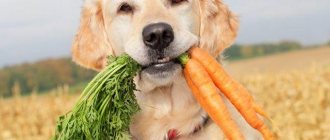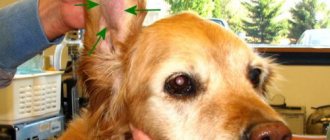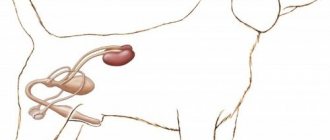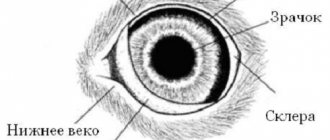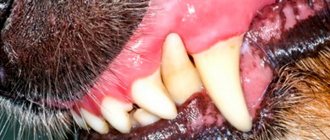What is toxocariasis
This is an unpleasant disease during which large and mature worms appear in the body, feeding on digested food from the intestines of the animal.
Spaghetti, as parasites are also called, have a length of 7-20 cm and a width of about 3-4 mm. The most dangerous are the females, who reproduce several million larvae.
The problem can be identified even without tests, since worms negatively affect the dog’s well-being, causing him a lot of inconvenience.
Restoration of the body
Do not forget about the activities that parasites carry out in the body. If their presence in the body caused, for example, bronchopneumonia, then after expelling the nematodes, it is necessary to begin treating this disease. Therefore, observation by a veterinarian for a long time is most often required.
It is important that you and your loved ones do not become infected from your pet. To do this, it is enough to limit communication with him for some time. For example, you shouldn’t pick him up for a while. Of course, you need to follow basic hygiene rules: wash your hands often with soap and wash your floors with disinfectant.
Symptoms
Signs depend on the severity of the disease. Manifestations of the disease:
- Dull fur, hair loss.
- Poor appetite.
- Constant skin itching, symptoms similar to dermatitis.
- Frequent vomiting.
Abdominal pain: The dog may arch his back, lie on his stomach, trying to hide it. Often the four-legged friend whines, trying to hide away.- Diarrhea.
- Weight loss.
- Intestinal obstruction (in advanced cases).
Since worms move freely throughout the body, other signs make themselves known in the form of periodic coughing, poor sleep, kidney problems, etc. Based on the location of the parasites, symptoms are distinguished.
Development of the parasite
The egg enters the digestive tract and the development of the roundworm begins. The larva that hatches here moves along with the food into the small intestine. Having bitten through the wall of the latter, the helminth enters a blood vessel and, together with the blood, reaches the liver, heart or lung. Most often they settle in the lungs, where they live for about two weeks. Because of this, dogs begin to cough and develop bronchitis. Together with sputum, the larva again ends up in the gastrointestinal tract. Here it develops into a mature individual.
Temporary shelters for nematodes include the lungs, heart, liver, pancreas, kidneys or muscles. Symptoms of toxocariasis in dogs will depend on which organ is affected. In this case, doctors may suspect heart, kidney or pulmonary failure. If the larva gets into the muscle, it becomes encapsulated, and this leads to an abscess.
What should a loving owner pay attention to? First of all, on the deworming scheme. Starting from two weeks of age, it is necessary to regularly feed your pet the recommended medications. Of course, they are also toxic, so taking preventive measures is not recommended more often. But if you notice one or more of the listed symptoms, then an extraordinary course is necessary. If treatment of toxocariasis in a dog is carried out at an early stage, it will take much less time and will be highly effective.
The first symptoms are:
- Loss of appetite.
- Development of anemia.
- Vomiting and stomach upset.
If you notice that your pet's constipation is replaced by severe diarrhea, then you need to bring this to the attention of your veterinarian. An infected dog becomes nervous and its behavior changes. Vomiting with loss of helminths may occur. Intestinal colic occurs, which is accompanied by refusal to eat. Bronchopneumonia often develops.
Maturation of Toxocara eggs and its varieties
There are several types of these helminths. There are toxocara in cats, dogs, cattle, and there are those that parasitize domestic animals and people.
The development cycle of worms is complex.
Once in the ground from feces, the larvae can remain in it for a long time and not cause infection until they mature. From this period, when toxocara enters the body, it becomes dangerous. For rapid development to occur, the soil must be moist and the air temperature must be within +23...+30 °C. Under such conditions, the larva becomes a full-fledged worm within 6-8 days.
When the air temperature is within +15 °C, the eggs need about 35 days to go through the entire development stage. In extreme heat (+40 °C), Toxocara die within 7 days. The eggs dry out under the scorching sun.
Interestingly, the larvae can spend the winter under the snow, and in the spring, when conditions are favorable, they will turn into dangerous worms.
What they look like in feces
It is impossible to notice the larvae in feces because they have a brown tint. You can see the eggs under a microscope: they are round in shape, the shell is dense and sticky, which allows the larvae to attach perfectly to surfaces.
In the feces, medium and large specimens are visible, some reaching 18 cm in length. A distinctive feature of Toxocara is the thickening of the head: they are slightly larger on one side.
However, it is difficult for a person who is not well versed in helminths to recognize and identify them.
If you notice white moving dots or worms of any length in your animal's stool, you should contact your veterinarian.
Clinical picture: features of helminthiasis
In the first days of infection, the disease practically does not manifest itself at all.
Unpleasant sensations arise when worms emerge from eggs and become active in the intestines. The more “spaghetti” becomes, the more the furry friend’s well-being deteriorates. Sometimes more than one month passes before the owner notices that something wrong is happening to the animal.
All this time, eggs and worms accumulate, and the animal’s immunity weakens.
Allergic reactions
Parasites don't just live in the intestines. They feed on its contents and poison the body with their secretions. As a result, the animal’s well-being deteriorates sharply. This is especially true for puppies, whose bodies are still very delicate and sensitive to intoxication.
Puppies begin to bark for a long time. They are developmentally delayed. If you do a blood test, you can note a decrease in hemoglobin and red blood cells. But there are more eosinophils and leukocytes. Often in young individuals, infection with helminths is accompanied by allergic reactions, expressed in the following:
- baldness of certain areas of the skin;
- eczema or allergic dermatitis;
- unbearable itching;
- their wool loses its attractiveness, beauty and shine;
- the stomach increases;
- puppies develop a severe cough, it lasts about two weeks, and then goes away, but the condition does not improve, because the growing parasites move into the gastrointestinal tract and continue to poison the body with their secretions;
- in advanced cases, you can see how the parasites come out along with the feces - this means that the stomach is full of them.
Causes of the disease
There are few causes of toxocariasis. This is due to the fact that the larvae are in the soil, and the carriers of the disease are rats and mice.
A dog can become infected:
- P
picking up something on the street from the soil where mature larvae are located. - By eating an infected rodent.
- Having “received” the disease through mother’s milk.
- Drinking from a polluted spring
In apartment conditions, the disease is rarely transmitted from dog to dog: the larvae on the animal’s fur quickly die.
Diagnosis in dogs
The disease appears some time after infection. The symptoms cannot be missed. The four-legged friend begins to eat poorly, worry, and behave unusually.
How to find out about infection
If you notice that something is wrong with your pet, you need to examine the feces.
If there are traces of worms in the digested remains of food, then it is necessary to examine the animal to exclude or confirm the presence of the disease.
Special studies
Many pet owners do not know how to find out if their pet has toxocariasis. Research consists of:
blood and urine tests;- enzyme immunoassay of blood serum;
- Ultrasound of the abdominal cavity, chest.
The veterinarian prescribes manipulations.
Analysis for toxocariasis
To rule out disease, a stool test can be done to check for worm eggs. This additional study makes it possible to determine what type of helminths the dog has.
general description
Toxocara is a fairly large nematode that is white or light yellow in color. The body is fusiform, covered with a cuticle; in addition, it has cervical cuticular wings that form a hood on the head. Length from 5 to 18 cm. The tail end of the male is curved, while in the female it is straight and cone-shaped. The mouth opening is framed by thick lips. The maximum lifespan is 6 months.
According to statistics, every second dog is a carrier of this parasite. Therefore, you need to carefully follow the veterinarian’s recommendations and carry out deworming on time. Toxocariasis in dogs manifests itself in different ways. Sometimes we start treating our pets for non-existent diseases, but in fact, it was necessary to rid them of parasites.
Treatment regimens
Therapy is prescribed by a veterinarian. Only in this case can a positive result be achieved.
Treatment consists of taking medications and following a diet.
Clear instructions must be followed.
Medicines
Antihelmintics are used:
- Fenkur;
- Pyrantel;
- Drontal plus;
- Kaniverm;
- Mebendazole;
- Nilverm;
- Piperazine;
- Fenbendazole.
In order to restore the intestines and strengthen the immune system after treatment, it is worth giving the animal a little 10% propolis tincture, but after consulting a doctor.
For puppies, it is recommended to use Bars Spoton, which contains praziquantel and ivermectin.
For very young children, drugs have been developed to eliminate the disease with minimal toxicity.
This could be Fenbendazole or Drontal Junior. Lactating bitches have Stronghold drops rubbed into their fur.
Diet
Diet will help cure the disease faster. It consists of eating easily digestible and nutritious food.
It is recommended to give your furry friend:
lean boiled fish;- chicken, turkey or rabbit meat;
- rice and buckwheat porridge;
- boiled vegetables in small quantities;
- light and low-fat soups.
There is no need to force food into the animal.

